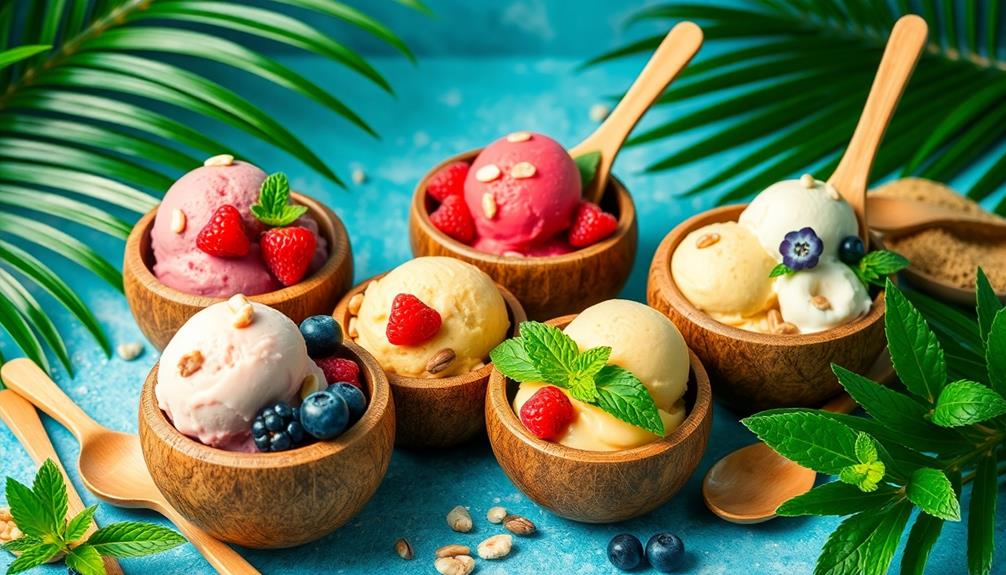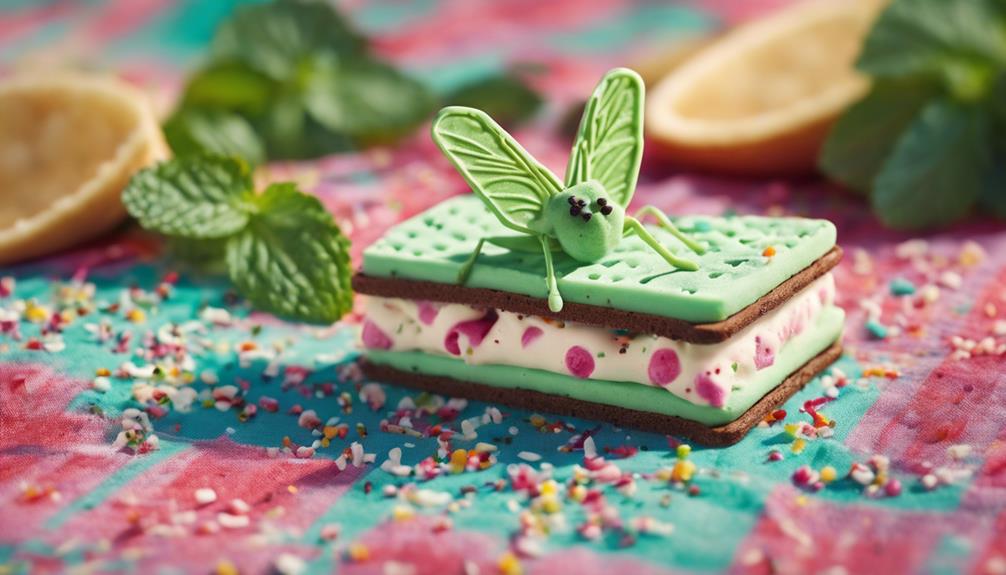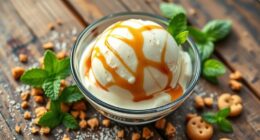Cultural fusion ice cream recipes let you explore exciting flavors from different traditions. You can try a Baklava Ice Cream Sundae, combining creamy vanilla ice cream with crispy phyllo, walnuts, and honey. Or whip up a warming Pumpkin Chai Ice Cream that blends seasonal pumpkin and chai spices. If you're feeling adventurous, give Kulfi a go, using cardamom and tropical lychee for that unique touch. Plus, there are gluten-free options, so everyone can enjoy. There's no limit to the creative combinations waiting for you, and pushing those boundaries can yield delicious surprises you won't want to miss.
Key Takeaways
- Explore bold flavor combinations like Baklava Ice Cream and Pumpkin Chai Ice Cream that celebrate diverse cultural traditions and ingredients.
- Incorporate traditional spices such as cardamom and saffron for unique twists on classic desserts like Kulfi and Persian Sheer Yakh.
- Create gluten-free options using coconut or almond milk, ensuring to check ingredient lists for hidden gluten.
- Utilize quick and easy recipes, such as Baklava Ice Cream Sundae, that require minimal preparation time and ingredients.
- Experiment with layering techniques by combining creamy ice creams with vibrant fruit sauces and crunchy nuts for visually appealing desserts.
Baklava Ice Cream Sundae
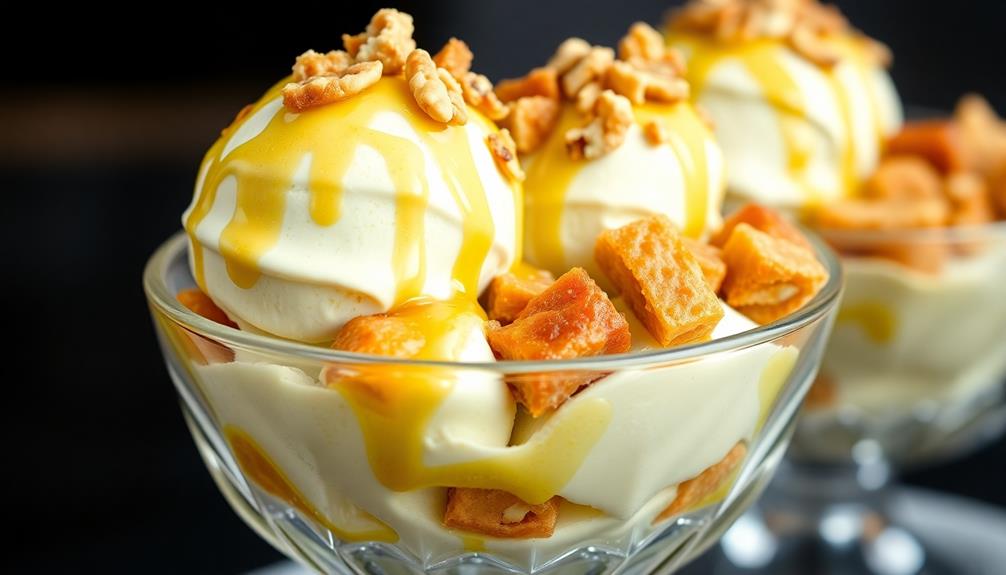
If you're craving a unique dessert experience, the Baklava Ice Cream Sundae is a must-try. This indulgent treat takes the classic idea of ice cream and combines it with the rich, nutty flavors of traditional baklava.
Picture layers of creamy vanilla ice cream, crispy phyllo dough, and a mix of walnuts and pistachios, all coming together to create a delightful fusion of textures and tastes.
The sundae is topped with warm honey, which not only adds sweetness but also enhances the baklava-inspired flavor profile. You'll love how quickly you can whip this up—preparation takes only about 10 minutes, making it perfect for any occasion.
Whether you're hosting a party or just satisfying your sweet tooth, this dessert is sure to impress.
Feel free to customize your sundae with additional toppings like cinnamon syrup or extra chopped nuts, giving it that extra flair.
This Baklava Ice Cream Sundae offers a fresh twist on traditional ice cream sundaes, appealing to dessert enthusiasts who are always on the lookout for innovative flavor combinations.
Immerse yourself in this treat, and you won't be disappointed!
Unique Flavor Profiles
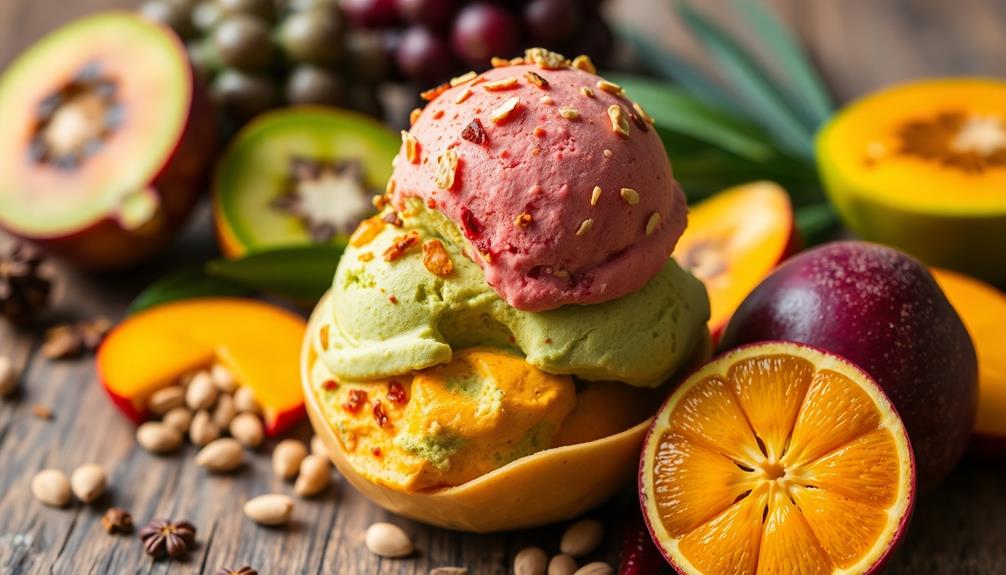
When you explore unique flavor profiles in cultural fusion ice cream, you'll discover bold combinations that surprise and delight your taste buds.
Think of how traditional ingredients, like cardamom and saffron, can transform a simple dessert into a culinary adventure.
These innovative blends not only celebrate diverse cultures but also create unforgettable treats that keep you coming back for more.
Bold Flavor Combinations
Bold flavor combinations in ice cream can transform a simple dessert into a culinary adventure that excites the palate. By embracing the fusion of cultures, you can experience unique flavor profiles that push the boundaries of traditional ice cream.
Imagine indulging in:
- A Baklava Ice Cream Sundae, where creamy ice cream meets the rich, nutty sweetness of honey and cinnamon.
- Kulfi infused with cardamom, adding a warm spice that elevates the classic Indian dessert to new heights.
- An invigorating lychee kulfi, showcasing tropical fruit that contrasts beautifully with the creamy base.
- Pumpkin chai ice cream, combining the cozy flavors of chai with seasonal pumpkin for a comforting twist.
These bold combinations not only tantalize your taste buds but also invite you to explore diverse culinary traditions.
The incorporation of diverse nuts like pistachios and walnuts adds texture and depth, making every scoop an exciting experience.
Cultural Ingredient Inspirations
Exploring cultural ingredient inspirations opens up a world of unique flavor profiles that elevate ice cream beyond the ordinary. For instance, homemade baklava ice cream combines the warmth of cinnamon and the crunch of pistachios, creating a flavor combination that pays homage to Middle Eastern desserts. You can infuse this rich, nutty essence into your ice cream, making each scoop a delightful experience.
Additionally, the use of easy homemade flautas as inspiration can lead to creative flavor pairings that resonate with diverse culinary traditions.
Another exciting option is kulfi, which introduces exotic fruits like lychee and spices like cardamom, showcasing Indian culinary traditions. This frozen treat captures local flavors, offering a revitalizing twist on traditional ice cream.
Persian sheer yakh takes a different approach by combining frozen milk with rosewater, resulting in a fragrant, cooling dessert that reflects Afghan heritage.
If you're craving something uniquely American, consider a fusion of peanut butter, fudge, and marshmallow, delivering a creamy, decadent experience.
Lastly, pumpkin chai ice cream merges classic fall spices with a smooth texture, appealing to seasonal tastes. By experimenting with these diverse ingredients, you'll create unforgettable ice cream flavors that celebrate cultural richness and innovation.
Cultural Influences
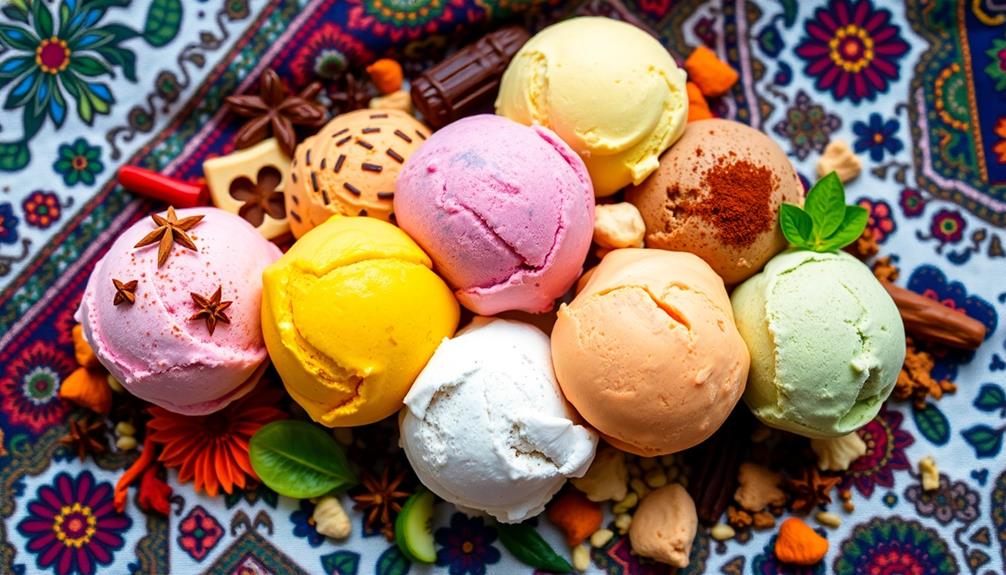
Cultural influences play a significant role in shaping the world of ice cream, bringing together flavors and techniques from diverse culinary traditions. You can discover unique and innovative desserts by embracing fusion.
Imagine indulging in:
- Baklava Ice Cream: A delightful mix of pistachios, honey, and cinnamon, capturing the essence of Middle Eastern sweets.
- Kulfi: This Indian treat features cardamom and saffron, transforming regional flavors into a creamy delight.
- Sheer Yakh: A Persian-inspired ice cream that combines milk and rosewater, reflecting the invigorating spirit of Afghan desserts.
- Mango Sticky Rice Sorbet: A Thai favorite, blending sweet mangoes with coconut milk, creating a tropical sensation.
Gluten-Free Ice Cream Options

Creating gluten-free ice cream options opens up a world of delicious possibilities for those with dietary restrictions. You can easily whip up homemade ice cream using alternative ingredients like coconut milk or almond milk instead of traditional dairy. This way, you maintain creamy textures without the gluten.
When adapting recipes, consider substituting gluten-containing ingredients, like cookies or cake, with gluten-free alternatives. This guarantees everyone can enjoy a sweet treat without worry. While many store-bought ice creams proudly display gluten-free labels, it's important to check ingredient lists for hidden gluten sources, especially in flavorings or mix-ins.
To inspire your gluten-free ice cream journey, here are some popular flavors you might want to try:
| Flavor | Base Ingredient | Gluten-Free Additions |
|---|---|---|
| Tropical Mango | Coconut Milk | Fresh mango chunks |
| Rich Chocolate | Almond Milk | Cocoa powder, chocolate chips |
| Nutty Hazelnut | Cashew Milk | Chopped hazelnuts |
| Berry Blast | Almond Milk | Mixed berries |
Homemade gluten-free ice cream not only allows you to control ingredients but also enables you to explore exciting and unique flavors!
Quick and Easy Recipes

Ready to whip up a delicious ice cream treat in no time? Quick and easy recipes are your best friends, especially when you want a homemade dessert without the fuss.
Take the Baklava Ice Cream Sundae, for example; you can prepare it in just 10 minutes with simple ingredients. Here's what you'll need:
- Creamy vanilla ice cream
- Crispy phyllo layers
- A sprinkle of nuts
- A drizzle of honey
Layering these ingredients not only enhances the visual appeal but also lets you experiment with flavors and textures.
Plus, you don't need an ice cream maker—manual freezing methods work great for this homemade ice cream recipe!
What's even better? You can easily customize your creation. Want it gluten-free? Swap in alternative ingredients to make it inclusive for everyone.
Adjust the nuts or sweeteners to match your taste. With quick recipes, the possibilities are endless, and you'll impress friends and family without spending hours in the kitchen.
Traditional Cuban Mantecado Ice Cream
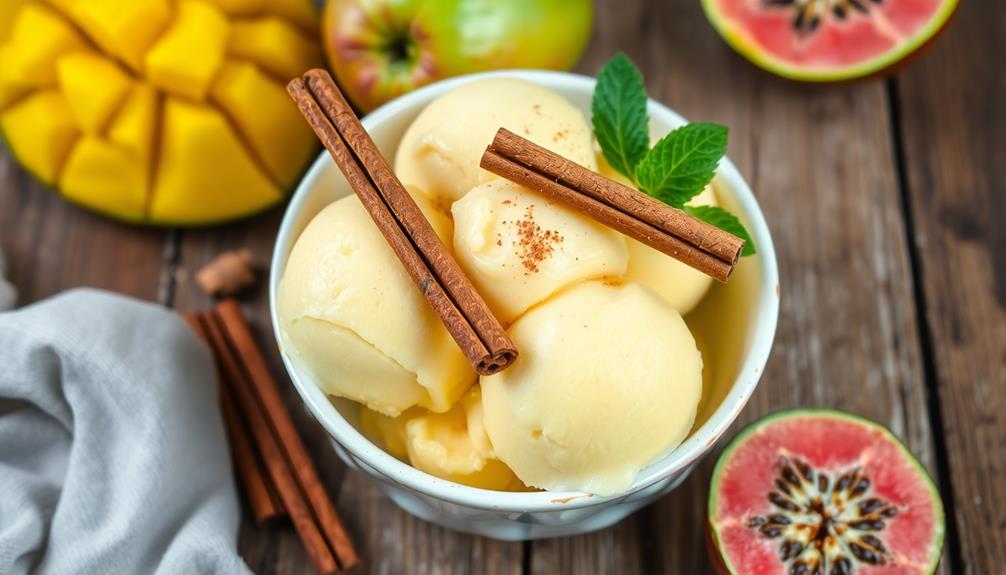
When you think of Traditional Cuban Mantecado ice cream, you're tapping into a rich history that marries simple ingredients with time-honored techniques.
This creamy dessert, made with egg yolks, sugar, and vanilla, showcases the heart of Cuban hospitality and celebration.
Let's explore the key components and methods that make this ice cream a beloved favorite.
Mantecado Ice Cream History
Mantecado ice cream has deep roots in Cuban culture, tracing its origins back to the 19th century through Spanish culinary influences. This traditional dessert embodies the essence of comfort, often enjoyed during family gatherings and celebrations.
With its creamy texture and rich flavor, it's no wonder that mantecado ice cream has become a staple in Cuban households.
Imagine indulging in:
- The velvety smoothness of vanilla ice cream
- Hints of cinnamon dancing on your palate
- The sweetness of local ingredients like coconut or guava
- The warmth and togetherness of a family gathering, sharing scoops of this beloved treat
Mantecado ice cream's simplicity is part of its charm, typically made with just milk, sugar, and egg yolks.
While vanilla is the star flavor, you might also find variations infused with local spices, showcasing the island's agricultural bounty.
This dessert goes beyond mere taste; it symbolizes hospitality and connection among loved ones.
As you savor each bite, you're not just enjoying a treat but also partaking in a rich history that celebrates Cuban culture and tradition.
Key Ingredients and Techniques
To create traditional Cuban mantecado ice cream, you'll need to gather a few key ingredients that come together to form a rich and creamy custard base. Start with egg yolks, whole milk, heavy cream, and sugar. These ingredients will provide the luscious texture you're after.
Don't forget a pinch of salt and a splash of vanilla extract to enhance the flavor profile. For that signature mantecado taste, incorporate cinnamon and nutmeg, which add a warm, aromatic quality to your ice cream.
Begin your recipe by whisking the egg yolks and sugar until they turn pale and fluffy. Then, slowly mix in the milk and cream until everything is well combined.
To achieve a smooth consistency, it's important to churn your mixture using an ice cream maker or a manual freezing method. This step helps prevent the formation of excessive ice crystals, ensuring your ice cream remains creamy.
After churning, let it freeze until it reaches your desired firmness. With these key ingredients and techniques, you'll master the art of making traditional Cuban mantecado ice cream that's sure to impress!
Layering Techniques for Desserts

Layering techniques can elevate your desserts from simple to spectacular, creating a feast for both the eyes and the palate. By stacking different components, you can craft delightful combinations that surprise with every bite. When using your ice cream maker, think about how each layer can complement the others in taste and texture.
Consider these elements for your next masterpiece:
- Creamy ice cream swirled with vibrant fruit sauces
- Crunchy nuts adding a satisfying contrast to soft layers
- Rich chocolate drizzle that enhances the overall flavor
- Fresh fruits providing a burst of color and natural sweetness
Using clear containers or glasses lets the beautiful colors and textures shine through.
Techniques like swirling sauces or employing a piping bag for precise layering can give your desserts a professional touch.
Don't hesitate to experiment with the order of your layers; you might discover unique combinations that elevate your dessert game.
With these layering techniques, you'll create visually stunning and delicious treats that everyone will love!
Sweet Treats for Special Occasions
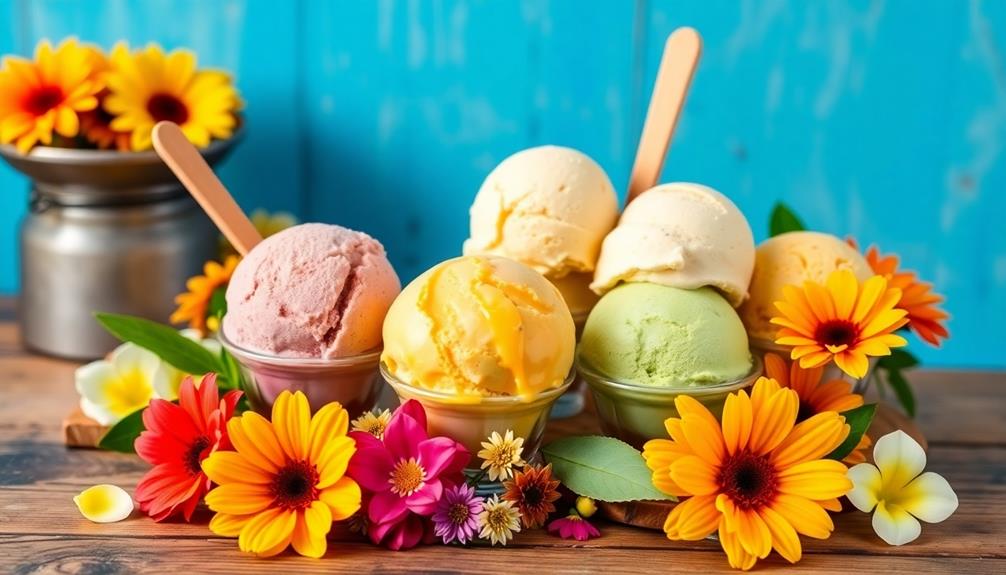
Celebrating special occasions calls for desserts that not only taste amazing but also look stunning. Ice cream offers a fantastic canvas for creating fusion flavors that can elevate your celebrations. Why not combine the rich, flaky goodness of nutty baklava with creamy ice cream? By layering pieces of baklava with your favorite ice cream, you create a visually appealing and delicious treat that impresses your guests.
Additionally, ice cream is a great way to incorporate fresh fruits, enhancing both flavor and nutrition, as they're known to be rich in antioxidants beneficial for overall health.
Preparing these ice cream desserts is surprisingly simple, making them perfect for last-minute gatherings. You can quickly whip up ice cream sundaes using vibrant fruits and sauces to enhance the presentation further. Imagine a colorful display of scoops topped with honey drizzles and crushed baklava—your guests will love it!
These desserts not only taste fantastic but also foster a sense of community as everyone shares in the experience of enjoying unique flavors. Incorporating traditional ingredients from various cultures into your ice cream recipes can truly enhance the festive atmosphere.
Frequently Asked Questions
What Are Some Common Bases for Fusion Ice Cream?
When creating fusion ice cream, you'll often use bases like cream, milk, or coconut milk. These ingredients blend well with various flavors, allowing you to experiment with unique combinations that surprise and delight your taste buds.
How Can I Adjust Sweetness in Fusion Ice Cream Recipes?
You can adjust sweetness in your recipes by adding more or less sugar, experimenting with natural sweeteners, or incorporating fruits. Taste as you go, and remember to balance sweetness with other flavors for the best result.
Are There Dairy-Free Options for Cultural Fusion Ice Cream?
When it comes to dairy-free options, you're in luck! You can easily swap out traditional dairy with coconut milk, almond milk, or cashew cream. These alternatives can create delicious, creamy textures without the lactose. Enjoy experimenting!
How Do I Store Leftover Fusion Ice Cream?
To store leftover fusion ice cream, scoop it into an airtight container, press a piece of parchment paper directly onto the surface, and seal it tightly. Keep it in the freezer to maintain its texture.
Can I Use Seasonal Fruits in Fusion Ice Cream Recipes?
Absolutely, you can use seasonal fruits in your fusion ice cream! Just imagine the vibrant flavors bursting in your mouth. Experimenting with fresh fruits can elevate your creations, making each scoop a delightful surprise.
Conclusion
Incorporating cultural fusion into your ice cream creations not only tantalizes your taste buds but also bridges traditions. As you whip up Baklava Ice Cream Sundaes or Cuban Mantecado, remember that these flavors are like a time machine, transporting you to different corners of the world. Don't hesitate to experiment with layering techniques and gluten-free options; after all, life's too short to stick to plain vanilla! Embrace the delicious diversity and make every scoop an adventure.


